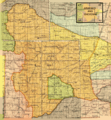Cheyenne people facts for kids
The Cheyenne are a well-known Native American tribe. They are part of the Algonquian language family. For many years, they lived on the Great Plains of North America. They were famous for their skills in hunting buffalo and their unique way of life.
Contents
The Cheyenne People
Who Are the Cheyenne?
The Cheyenne people originally lived in the Great Lakes region. Over time, they moved westward. They eventually settled on the Great Plains. This area includes parts of what is now Colorado, Wyoming, Nebraska, and Kansas. The Cheyenne became expert horse riders and buffalo hunters. Their name, "Cheyenne," might come from a Sioux word meaning "people of a different speech."
Life on the Plains
Life for the Cheyenne on the Great Plains revolved around the buffalo. Buffalo provided almost everything they needed. This included food, clothing, and materials for their homes. The Cheyenne were skilled hunters. They used bows and arrows, and later, rifles.
Homes and Villages
The Cheyenne lived in two main types of homes. They used earth lodges with wood frames covered in dirt. These were more permanent homes. They also lived in teepees. Teepees were made from long wooden poles and buffalo hides. Teepees were easy to set up and take down. This made them perfect for a nomadic lifestyle. A nomadic lifestyle means moving from place to place. This was important for following the buffalo herds.
Social Structure
The Cheyenne society was well-organized. It was made up of different bands. Each band had its own leaders. There were also warrior societies. These groups trained young men to be brave and protect the tribe. Women played a very important role too. They prepared food, made clothing, and cared for the children. Everyone worked together for the good of the community.
Culture and Traditions
The Cheyenne had rich cultural traditions. Storytelling was a big part of their lives. They passed down their history and values through stories. Ceremonies were also very important. The Sun Dance was one of their most sacred ceremonies. It was a time for prayer, renewal, and showing thanks. Art was also a key part of Cheyenne culture. They created beautiful beadwork, quillwork, and ledger art. Ledger art was drawings on old ledger books.
Important Events in Cheyenne History
The 1800s brought many changes for the Cheyenne. More and more settlers moved onto their lands. This led to conflicts over land and resources. The United States government made treaties with the Cheyenne. These treaties often reduced the size of their traditional lands.
Famous Leaders
Several Cheyenne leaders are remembered for their courage and wisdom.
- Black Kettle was a chief of the Southern Cheyenne. He worked hard for peace between his people and the United States.
- Dull Knife (also known as Morning Star) was a chief of the Northern Cheyenne. He led his people through very difficult times.
- Little Wolf (also known as Little Coyote) was another brave Northern Cheyenne chief. He was known for his military skills.
These leaders tried to protect their people and their way of life.
The Cheyenne Today
Today, the Cheyenne people continue to thrive. They live on reservations in Montana and Oklahoma. The Northern Cheyenne Indian Reservation is in Montana. The Southern Cheyenne and Arapaho Tribes live in Oklahoma.
The Cheyenne people work hard to preserve their culture, language, and traditions. They teach their children about their history. They also celebrate their heritage through powwows and cultural events. Many Cheyenne people serve in the United States military. They contribute to society in many different ways.
Images for kids
-
Cheyenne hide dress, c. 1920, Gilcrease Museum
-
Cheyenne beaded hide shirt, Woolaroc
-
W. Richard West Jr., former director and cofounder of the Smithsonian's National Museum of the American Indian
-
Cheyenne woman photograph by Edward S. Curtis, 1930
-
Portrait of Cheyenne chief Wolf-on-the-Hill by George Catlin, 1832. A band of Cheyenne visited Fort Pierre, South Dakota in 1832 where some were painted by Catlin during a westward expedition.
-
Ledger drawing of a Cheyenne warrior with pronghorn horned headdress, symbol of the Crazy Dog Society.
-
Dull Knife (Cheyenne: Vóóhéhéve or Lakota: Tamílapéšni), Chief of Northern Cheyenne at Battle of the Little Bighorn
-
Chief Black Kettle of the Southern Cheyenne, an advocate of peace among his people.
-
Little Coyote (Little Wolf) and Morning Star (Dull Knife), chiefs of the Northern Cheyenne
-
White Buffalo, a Northern Cheyenne chief who received the rank of sergeant in the United States Army.
See also
 In Spanish: Cheyenes para niños
In Spanish: Cheyenes para niños


















